New World Record - The World's Largest Guitar Effects Pedalboard

A new record has been set
In the world there are a lot of people who always seek to achieve some incredible feat, worthy of admiration and enjoyment, but for some reasons not many come to achieve it, however there will always be those who want to try again and again until they achieve the incredible.

When people manage to make themselves known for some shocking feat, their effort, if it is completely wonderful, is recognized through a title which is related to a world record.
Setting a world record is a feat that not many are able to achieve because it takes determination, creativity and perseverance to achieve this title, yet many continue to be part of this important recognition of the effort.
Rob Scallon and Sweetwater have joined talents to achieve a great demonstration
Sweetwater and guitarist Rob Scallon have come together with the idea of being part of the select list of people who essentially achieved something unimaginable, and in this case they have managed to set a record by creating the pedalboard with the most pedals for guitar effects.
Sweetwater, the company responsible for the distribution of audio equipment, teamed up with the YouTuber and instrumentalist, who we mostly know from his great content on Youtube such as banjo covers of Metallica and Slayer songs, to achieve something never seen before.

The World's Largest Guitar Effects Pedalboard
For some time the idea of breaking this record had been forming, and the company most interested in achieving it was Sweetwater, who along with the famous youtuber Rob Scallon accomplished this feat in a spectacular way.
319 pedals with unique effects were installed in a 21-meter structure and were distributed among 34 pedals, which were tested by Scallon once they were fully operational.
On July 9, this work was completed, which was not only composed of these 319 pedals from 34 different manufacturers, but also carried a little more than 500 meters of cable to connect and feed each of the components belonging to this Large structure of variable sound effects.
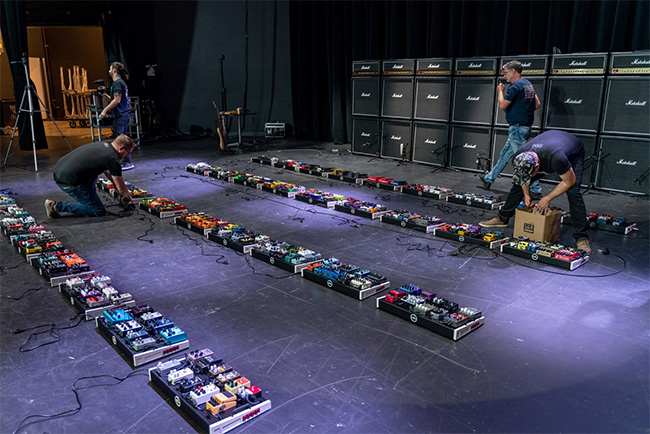
Each of the sound forms is really variable and hard work was needed to achieve the particularity and clarity of each of the sounds modified by the pedals. The process of preparing for a world record is similar to traveling a road whose length is divided into several parts:
The wonderful idea
Rob Scallon had a wonderful idea that was guided by his love for music, especially for his affection for a particular instrument: GUITARS; That is why he wanted to establish a new brand in the Guinness record book and to achieve this he has shared efforts with Sweetwater, who is known for providing audio equipment that possesses the technology he was looking for.
Surely something spectacular was going to result from the combination of a fan of technology applied to music and a musician whose love extends to almost all existing musical instruments.
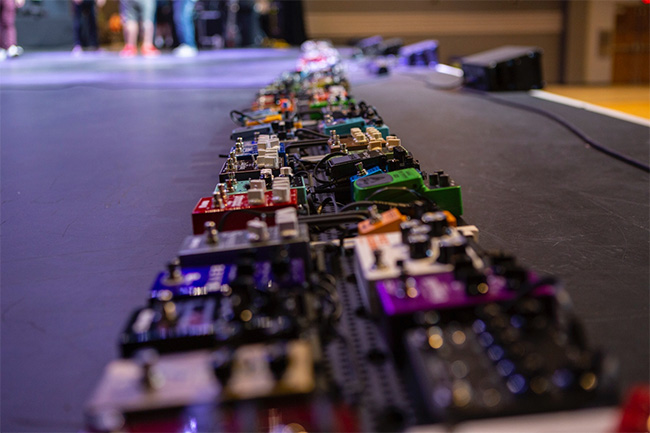
The materialization of everything: Those involved
In order to realize this musical idea, a great effort would be needed, so Sweetwater gathered a large team of employees who would be the main collaborators to achieve it, but not only a large number of people were needed, but that each element involved was the professional more qualified for each of the tasks that would be assigned.
The summary of those involved in this difficult task was:
From Sweetwater: Engineers Shawn Dealey, Andrew Plassman, Charlie Davis, Ben Porter, David Hess, Geoff Allen, Robert Williams, Dave Dunsire and Philip Courtney took care of much of the work.
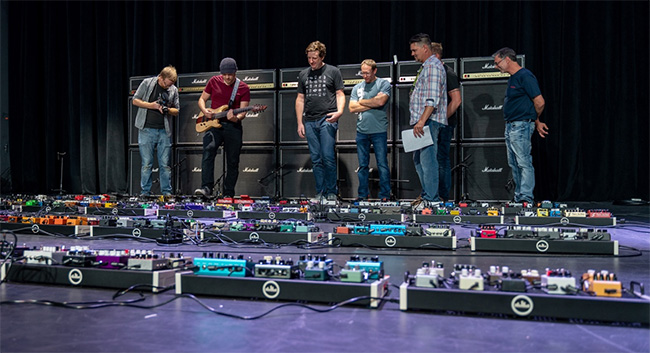
Also designers Josh Scott from JHS Pedals, for Temple Audio was present Ryan Dyck, Brian Wampler of Wampler Pedals and Robert Keeley of Keeley Electronics.
On the other hand for the assembly part Rob Scallon himself also assembled his own team and transferred it to the Clyde Theater in Illinois.
Preparation and connection of equipment
Once the staff was gathered, it was required to evaluate each of the elements that would be part of this great structure, so a varied group of diverse teams was chosen carefully that would amplify and modify each of the sounds that would be emitted for a guitar driven by Scallon.
The chain of elements that would be part of the feat
The 319 pedals were needed, also a total of 34 pedals, 7 amplifier heads, and 14 extension cabinets, and of course a guitar and a performer who knew his instrument well (in addition to the more 500 meters of cable for connections).
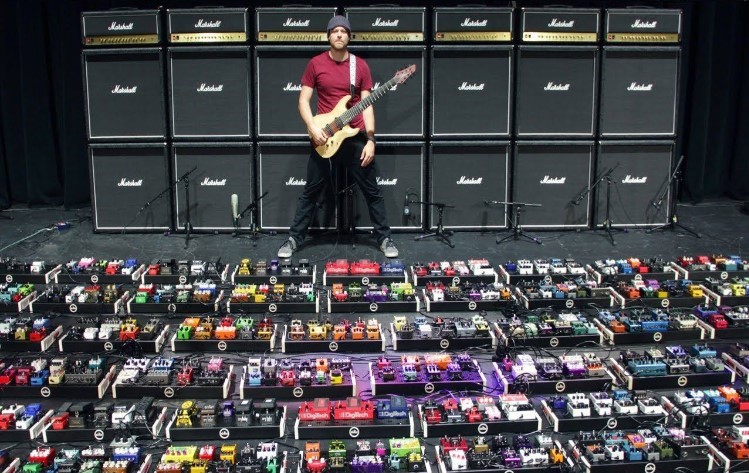
In order to initiate the connection of all the parts that would form the idea completely, the installation and preparation of the elements that would be connected to the guitar was performed first, that is to say that it would be connected through a Shure AD4DUS wireless device that would be connected to EarthQuaker Devices Swiss Things acting like a switch.
After connecting the guitar, the necessary adjustments would be made to connect the pedals, and this was a fairly complex equipment consisting of: Wah pedals, tuners, loopers, bass effects, distortions, fuzzes, gates, noise suppressors, delays, emulators of synthesizers, compressors, amplifiers, pre amplifiers, modulation boxes, overdrives, equalizers, harmonization pedals and keyboard, all this connected to give the sound a great variety and to achieve the goal spectacularly.
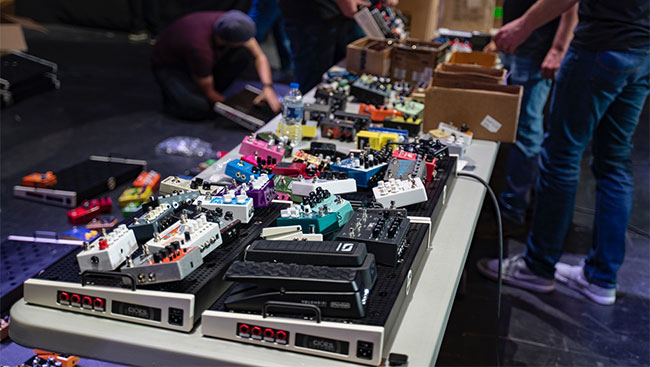
Each pedal was connected to a single circuit, but each of these had to have a method for activating and deactivating the pedal individually and the connection cables were made to measure, that is to say personalized.
All these elements would add almost 1000 watts of power, so by the time the feat was performed the sound was simply wonderful, that's how they managed to overcome the mark imposed in the past and managed to be part of the story.
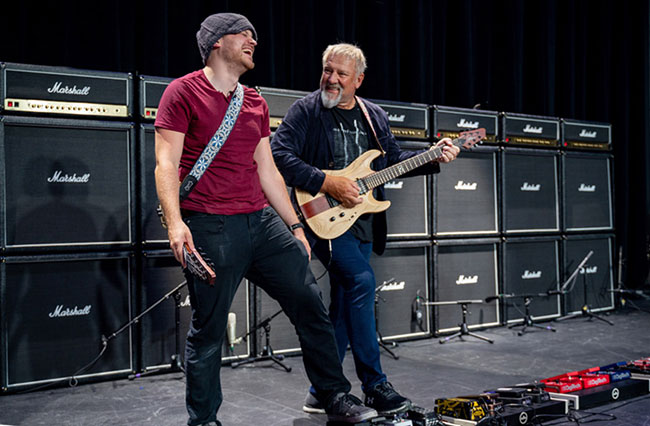
Curious fact
The day the tests were conducted, in Sweetwater was Rush guitarist Alex Lifeson, who stopped for a moment to test the sounds of this huge pedal board, this made the feat become even more spectacular.
Precedents
Previously other people have also wanted to achieve maximum recognition when trying to build the world's largest pedal board, in fact, the last attempt was made approximately 10 years ago, but the number of pedals reached around 150, this means that the Mark that Rob Scallon and Sweetwater have left has been more than double what had been achieved.



